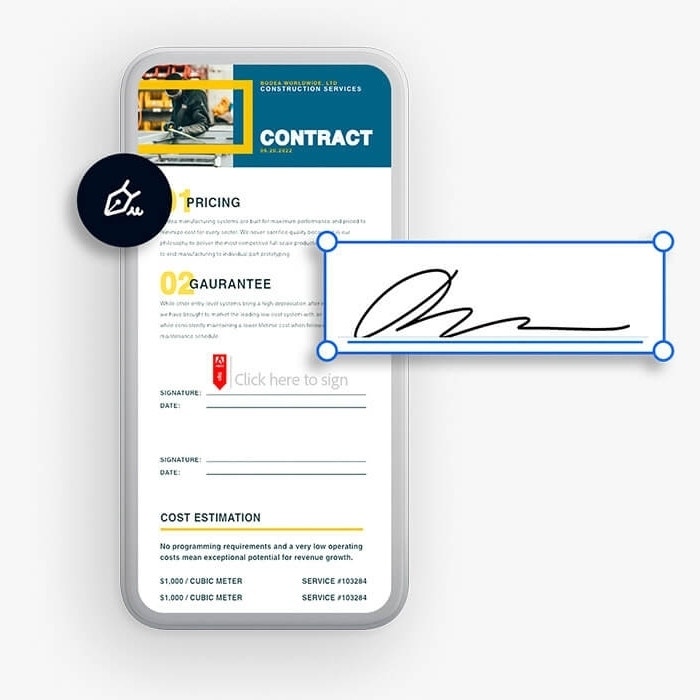Acrobat Sign
Work fast with subcontractor agreements.
A subcontract agreement is an essential component of onboarding subcontractors. This is what goes into one, and how to get them signed faster.

What is a subcontractor agreement?
Agreements define who does what on a project. They outline schedules and benchmarks for jobs, state budgets, and clarify important issues like legal liability and indemnification. Clients make agreements with contractors. Contractors, in turn, make agreements with subcontractors via subcontractor agreements.
Hire contractors the right way.
Construction industry professionals need to know their craft, their clients, and their construction contracts. That’s true for large construction companies, general contractors who oversee employees, and independent contractors who work alone. Before anyone can dig into a foundation or lay a single brick, every party needs to know their roles as they are clearly defined in a written agreement.
The real first step to any construction project isn’t laying a cornerstone in a foundation. It’s putting a signature at the bottom of a legal document. Gathering those signatures the right way is crucial to getting work underway.
Speed up subcontracting with e-signatures.
Onboarding can take time. Sending out paper contracts, getting everyone to sign on the dotted line, putting those contracts in the hands of the relevant authorities, and then copying and filing them can hold up a project.
When hiring subcontractors, time is of the essence and documentation is crucial. E-signatures speed up the process of onboarding subcontractors, letting everyone get to work as soon as possible. That’s true for mom-and-pop contracting companies, and it’s also true of large enterprises who want to speed up operations across the board.
Digital signature success stories.
Accelerating contracts can make an entire organization more efficient. That is true for small, locally focused construction companies and for large enterprises — for contractors and subcontractors alike.
Hitting the road faster with Ryder.
Ryder specializes in transportation and logistics, especially with commercial trucking. The company wanted to reduce the cost and impact of printing, mailing, storing, and working with physical paper. By going digital with Acrobat Sign, they were able to support 7,000 digital transactions per month and sign new contracts three times faster. That meant less time on administrative tasks and more time hard at work.
Taking to the skies with Airbus.
Aerospace titan Airbus processes thousands of contracts every year. By adopting e-signatures and paperless contracts, the company was able to streamline HR processes and reduce signing time for essential documents from from several hours to just 15 minutes.
What is the difference between a contractor and a subcontractor?
Subcontractors are contractors. The difference between a subcontractor and contractor is not necessarily the kind of work they do or services they provide. It’s their relationship with the client. Contractors work for and negotiate with the client directly. Subcontractors work with the contractor and only indirectly with the client.
Designations of who’s a contractor and who’s a subcontractor is a matter of legal liability. Depending on the laws of the state or local regulations, a contractor or owner can shield themselves from some liability in the event of subcontractor negligence, and a proper understanding of those roles is important for dispute resolution and arbitration.
Depending on a subcontractor’s work, subcontractors can also hire sub-subcontractors. When that happens, subcontractors need new agreements to sign that work with their agreements with the contractor, and what the contractor has agreed to with the owner. Because a large project can have so many layers of contracting and subcontracting, it’s important to gather e-signatures quickly.
Different applicable laws can also more specifically define who is and is not a subcontractor in specific situations. Check governing laws to make sure that you actually can subcontract work and whether or not there’s any specific governing law you need to plan for.

What to include in subcontractor agreements.
Subcontractor agreements must be clear, well defined, and tailored to a specific job. The contractor agreement should include:
- Scope of work and subcontractor’s responsibilities
- Work hours
- Deadlines
- Time-tracking tools for contractors or freelancers
- KPIs and benchmarks
- Insurance requirements
- NDA and other relevant confidentiality agreements
- Ownership information
- Notice periods
- Intellectual property agreements
- Nondisclosure agreements
- Indemnity clause
- Invoicing, payment, and billing terms
- Workers’ compensation, flat fees, and other payment details
- Termination details
- Any other clauses required by local laws

Get subcontractor agreements finalized faster with Acrobat Sign and Document Cloud.
Adobe Document Cloud provides a common repository for contracts and other important documents. Scopes of work, expectations, and KPIs are all a click away on any mobile device or desktop, for anyone to access. That way, everyone can focus on what’s really important — delivering quality workmanship, finishing the project, and building something together.
